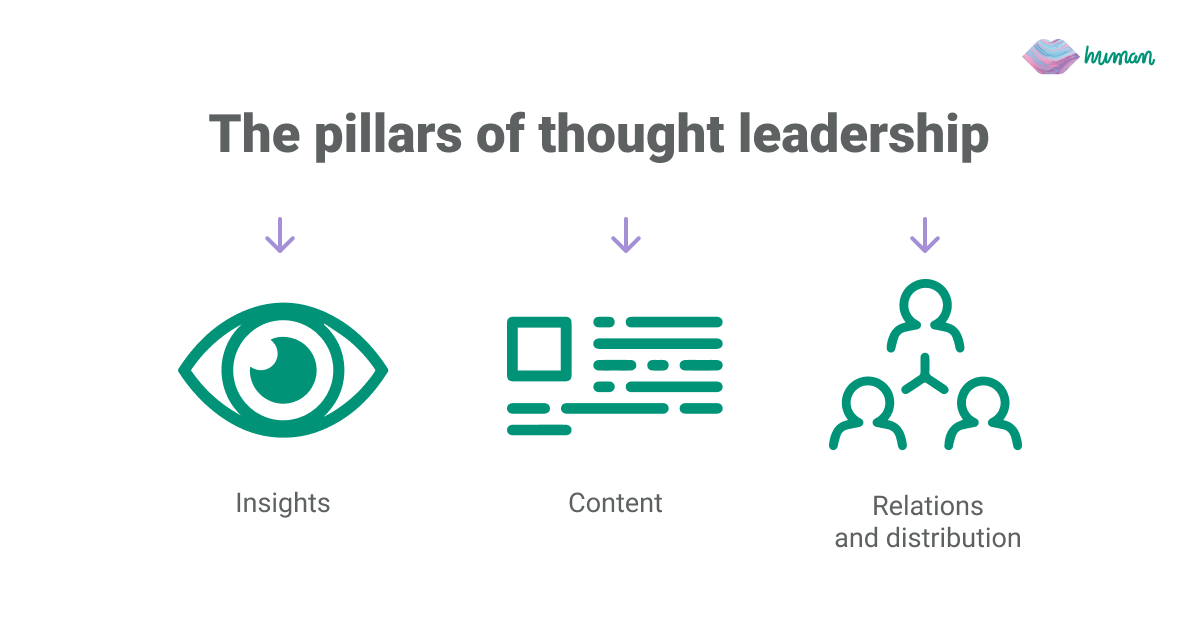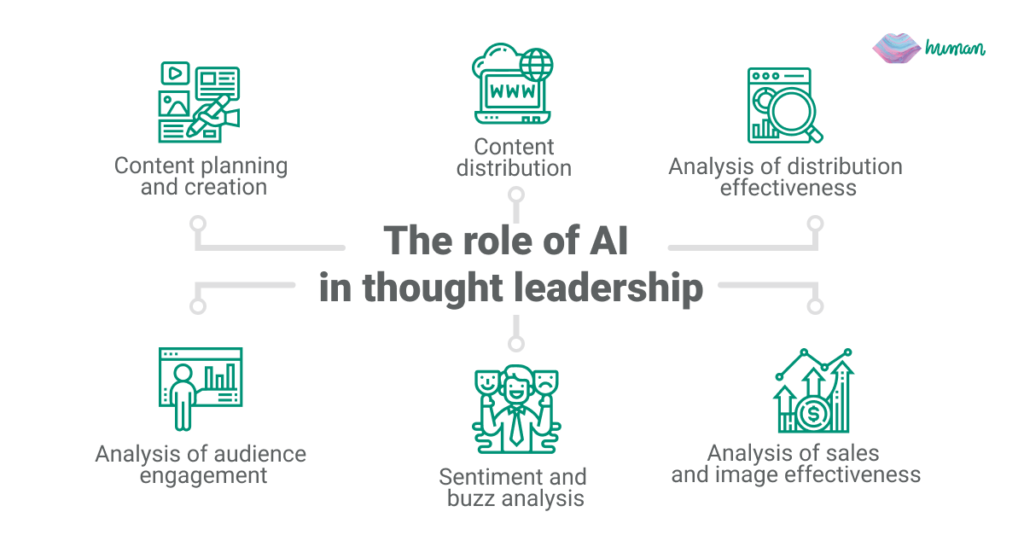What do you think about thought leadership?
In the era of the marketing revolution caused by AI tools, we are facing a redefinition of this concept. Content created by AI content generators has started flooding the market since the beginning of 2023. The ease of creating with the use of AI tempts companies that not only didn’t have the time but also lacked the competence.
Therefore, we can assume that the role of human touch, original insight, real competence and human emotions will grow significantly over the next few months once we encounter an influx of low-quality generic content. Even more than before, we will need real authors as well as content curators to sort the wheat from the chaff.
This applies to B2B marketing, in which thought leadership based on qualitative, credible, authentic content plays an increasingly important role, especially considering the limited budgets, long shopping paths and intense competition.
The era of thought leadership is still going strong. Only 5.1% of marketers who answered in the Semrush study do not include thought leadership in their activities. In B2B, actively helping your potential clients, and providing them with inspiration and guidance that allows them to navigate the business world, is becoming the norm. Respondents of the aforementioned Semrush study focus mostly on inspirational content that drives changes (60.9%) and educational content (66 5%).
However, the challenge will be to effectively break through the plethora of generic content and consistently build your position. How to do it? How to create content based on authentic, original thought that helps change businesses for the better? When we operate in the reality of AI-generated content, we need to approach it methodically and strategically. Only a well-thought-out approach, combined with personal competence, can help us gain a competitive edge.
Let’s check who benefits from thought leadership, how to approach its planning, and how to measure its results. And finally, how to deal with it when we do not have the appropriate processing capacity, but we feel and understand its real value.
Let’s dive in!
How to understand thought leadership in B2B? And for whom is it a good solution?
As many definitions of thought leadership, as many authors. They usually include terms such as “core breaking ideas”, “topic of great relevance” “insightful points of view”, “expertise”, “unique guidance”, “inspiring innovation”, “authentic and genuine content”, etc.
For B2B purposes, I understand it as:
Supporting trust in the brand by building and strengthening the expert image of the leaders representing it. It can be done by strategically creating and distributing content that generates value for the recipient – authentic and substantive, based on personal beliefs, knowledge, leadership competences and consistent with the business it represents. Thought leadership covers a wide range of forms – from ideas and insights, through analytical content, as well as those of a practical use. This content should focus on their importance for the author, business and recipients, their originality and boldness.
Who is it for?
Due to its nature, the thought leadership is an excellent solution, especially for specialists in B2B businesses characterized by a long purchasing process and a high customer acquisition cost. It will work well in the case of creating the image of managers, c-levels and specialists in the b2b tech industry, as well as general industries where technology and innovation meet the health, finance, biotech, consulting sectors – just to name a few.
In addition, it can also work well for senior executives – COO, CTO, CMO, CFO and others in B2B. It is also essential in the case of solopreneurs, for whom building their personal brand is crucial. However, a key thread should be noted – thought leadership is a solution for those who have expert: knowledge and charismatic personality. Your own voice is an essential piece of this puzzle.
Thought leadership, like any activity in B2B, requires you to create real value.
Goals that can be achieved by thought leadership in B2B
Well-planned thought leadership allows you to achieve not only the goals of the brand, but also the personal goals of an expert.
On a personal level, it allows you to build and strengthen the position of the expert in a given field, build a network of contacts and visibility in the media. Thanks to this, it engages authors more strongly and thus also requires authenticity. The expert must identify with the published content. They must also be able to defend it. The goal of their activities should be to become a go-to-expert in the selected field – to whom requests for statements and invitations will be directed.
At the brand level, in the long term, it is of course fuelling the pipeline. Before trust can be converted, it is necessary to build relationships with the environment – potential and current customers, partners, investors, job candidates and employees, and of course – the media. Quality thought leadership can help you shape a coherent brand image, create engaging message and build reach. This reduces marketing and sales costs, customer loyalty costs, as well as recruitment and PR costs.
It also gives a chance to influence the transformation of industries and niches, and in the case of innovative ideas – to inspire broader social or environmental changes. This can happen by raising important topics and supporting discussion or building a community around them. This is extremely important due to the specificity of the decision-making process in B2B. The process is longer, the purchase value is higher, and more people are involved in the decision-making. Shopping is definitely more rational. To a large extent, content in B2B is attributed to specific authors associated with the brand, specialised in given areas and working behind the development of sold solutions.
Importantly, thought leadership also helps to organically acquire qualitative publicity and build lasting relationships with the environment. You can’t forget about attracting potential valuable employees.
Its benefits are long-term and comprehensive.
Insights, content and relations – the pillars of thought leadership
You can profile yourself and choose strategic solutions, but you cannot define thought leadership only in terms of one type of activity. However, without one of the following pillars, thought leadership can turn into typical ghost writing.
It is worth dividing it into three key areas:
- insights: reports, research, original studies, analyses, desk research, lists, etc.
- content: publications, articles, digital assets, social content, ebooks, videos, podcasts, etc.
- relations and distribution: networking and events, relations with partners, media, and communities, speeches, publications with partners and paid and organic distribution in other channels.
Such a division indicates the need to combine analytical, networking and production work, tied together by an overriding idea.

Features of good thought leadership content – and a few words about AI and authenticity
Above, I pointed out one of the most important pieces of the puzzle related to creating content for thought leadership – the presence of real insights based on knowledge and research.
According to Edelman brand research from 2022, recipients expect experts to understand the problems of their organizations, as well as identify new opportunities and trends. They also expect insights in times of crisis: how the organization and our readers themselves can benefit from them.
Therefore, the content should be distinguished by expertise, originality and credibility.
It is worth noting the role of AI, which cannot be overlooked in the light of current trends. These three key features mentioned above make AI-generated content fall short of these criteria. Text needs to be planned, monitored, corrected, and shaped by an expert, and AI should only be used to increase the chances of content resonating with an audience.
How? Through support in research and analysis, searching for data and numbers, correlation, as well as content polishing and formatting. Both the mission – goal, key idea or strong, debatable topic, as well as the conclusions must come from a human expert. The aforementioned AI solutions can be useful in this field as boosters, helping to search for information, analyse, synthesise, polish or aesthetically wrap it. However, they can’t work as independent authors.

Thought leadership is not the same as ghostwriting. It is also not a direct PR activity – it should not be carried out by spin doctors. We can’t promise someone to become a thought leader when they have little to say – just like we can’t promise them to develop charisma.
In the case of B2C, content is usually not related to a person, but to a brand, and it is the brand that stands up for an important issue, connects with an idea important to the consumer and evokes emotions. This does not mean that B2B thought leadership is devoid of emotions. Good b2b content also brings emotions, delights with aesthetics, form, and individual style consistent with the style of the brand and the author themself.
Thought leadership must be based on genuine personal competence and real experts’ experience. Otherwise, the market will quickly verify any manipulations.
Challenges of thought leadership, or something about performance indicators
Why are large organizations sometimes afraid to use thought leadership?
In their case, thought leadership requires, above all, alignment with the personal goals of the leader with the goals of the organization. At the same time, it requires strategic cooperation of sales, PR, marketing, content and creative departments.
Meanwhile, the key challenge is the lack of internal awareness, often at the level of decision-makers. When the management board is focused on short-term goals and expects to boost sales results, the marketing team faces the challenge of proving the influence of thought leadership on acquiring leads. Then you need clear indicators of success – but as always, there’s no clear answer.
Ashley Faus proposes an analysis of thought leadership in 4 key dimensions:
- CREDIBILITY (level of perception as an expert by audiences),
- PROFILE (level of recognition and reach),
- PROLIFIC (frequency and variety of publications,
- DEPTH OF IDEAS (level of content expertise).
Thanks to them we can check the scale of our influence independently at different levels. Her proposal allows you to perfectly visualize the level of maturity of thought leadership at the individual and organizational levels and the goals that can be pursued.
In turn, TLN, supported by Financial Times and Longitude, published a great document with the telling title “Proving our value. A framework for measuring the effectiveness of thought leadership campaigns”. Experts point to 3 important areas in which thought leadership can be measured:
- Alignment – indicates the understanding and adaptation of the idea and the use of content created for thought leadership directly in the organization itself – and can be measured by the type and frequency of use of materials by employees in the organization (e.g., in public speeches, sales pitches, content shares)
- Engagement – can be used for benchmarking, and is based on vanity metrics – such as downloads, CTR, number of comments, views, etc. Engagement should be considered in relation to owned, paid, shared and borrowed channels. However, it cannot be a single indicator of success.
- Influence and impact – this is where the most important effects of thought leadership are hidden, reflected in the strong interdependence of brand equity, influence (understood as changing the thinking and behaviour of recipients) and revenue. Influence and impact measurement is the most important, but also the most difficult one. It should be specific to your organization and campaign.
What do you need to pay attention to? Thought leadership strategy
Thought leadership takes place at the intersection of content, PR, social media and networking, which is why it requires a holistic, strategic view. This is also indicated by the issues related to influence and impact measurements outlined above.
Whether you take care of thought leadership yourself or just outsource it, you must adopt a methodical approach:
Strategic analysis
Both your and your organization’s strengths and weaknesses, as well as market opportunities and threats, require analysis. You also need to pay attention to the specifics of your ICP and people holding positions within the purchasing committee. You cannot ignore the micro and macro trends affecting your industry and your business. You also need to look at your main competitors, scan the specifics of their activities and draw conclusions for the direction of your publications.
Defining the core idea
After the analysis, you will be better prepared to find and define the idea – the enemy you want to take a strong stand against, and the counter idea you want to promote and put your name to. This will help you in building strong statements, defining thought leadership content ideas and maintaining consistency in published materials.
Planning
Once you define the core ideas, there will be time to plan a thought leadership content strategy. It is necessary to develop a thematic framework and determine the channels and formats you want and can develop within your budget. At this stage, your resources and gaps that need to be filled or optimized are also determined.
Content production
The planning phase goes into the production phase – some content is necessary at the start of activities, and other content can be prepared later or will be prepared on a continuous basis.
Amplifying: engagement & evangelization
Amplifying is actually 60% of the work. It’s about creating and using our own platform to distribute our messages. We are talking about activity in social media, networking, partnerships, speaking at external webinars and events.
The types of activities must be selected for the specificity of the industry, the author’s competences and the budget – each time the palette should be selected individually at the start and adapted to the given campaign. Recycling and redistribution of content is also important here.
Measurement & refinishing
As with any other activity, analytics is essential and there is a constant feedback loop. I will mention how to measure thought leadership results below.
What’s next? Where to start? Begin with micro thought leadership
You may feel aspirations to build an image of a thought leader. Understanding the importance of substantive content in demand generation, your organization may require such actions from you.
But what if the idea of thought leadership seems too overwhelming or insubstantial? Start by testing communication on LinkedIn:
- Define your goals
- Choose key ideas that can resonate and are consistent with your business, your specialization as an expert and the needs of your target group
- Outline the framework (thematic pillars) of your posts
- Create ideas for your first posts
- Just write!
- Interact and expand your network of contacts
- Check, analyse and repeat.
If you don’t know where to start, you may need some help – content marketing and thought leadership expertise. You can define the scope of support expected from the team – from strategy to execution and constant management of your publications. In this case, you can expect packaged solutions tailored to your budget and the possibility of personal involvement.
You decide what form of action is acceptable to you. If you want to be heard and give your b2b business a chance to be noticed, take steps or start building thought leadership today, regardless of the planned scale.





